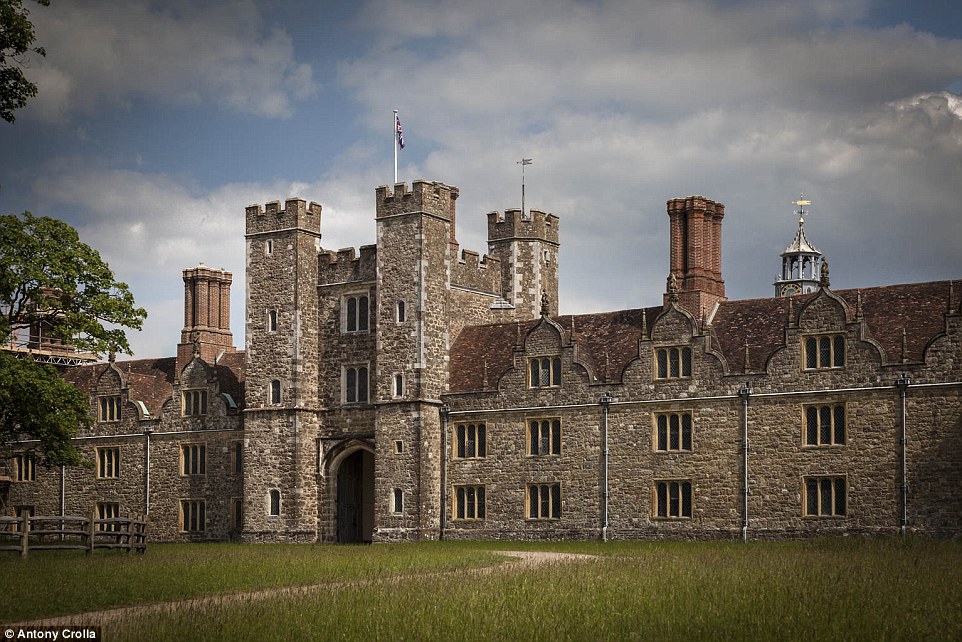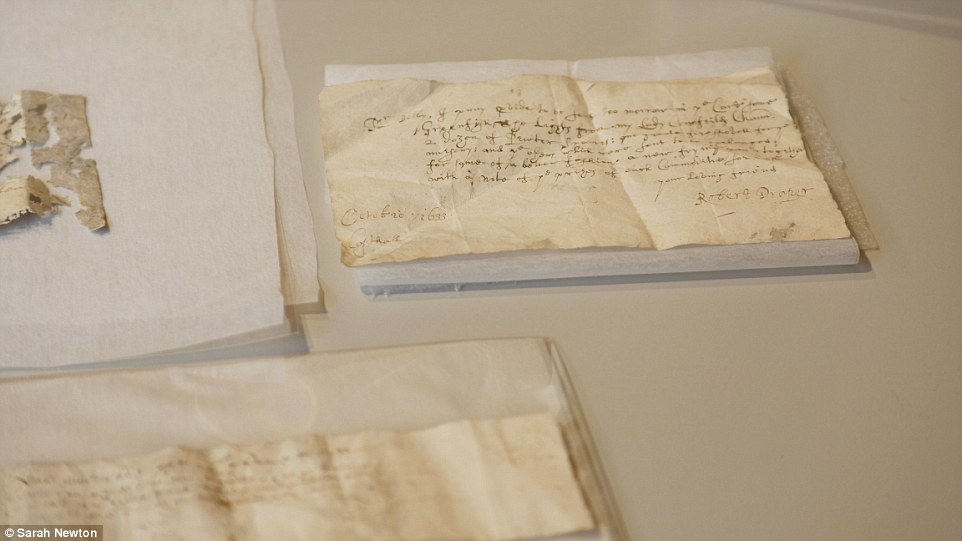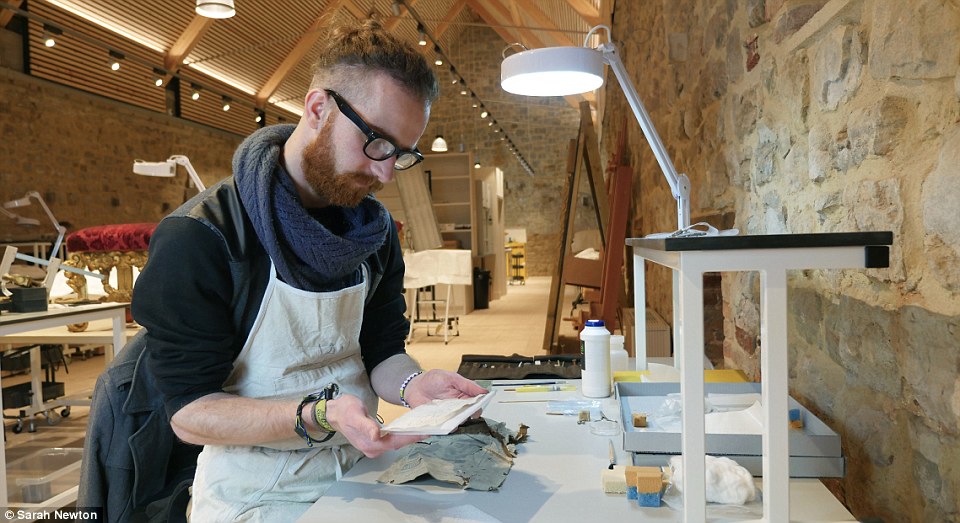A 400-year-old shopping list for 'green fish', pewter spoons and a new frying pan has been discovered under the floorboards of a historic Tudor mansion in Kent.
The shopping list and two other letters, dating from 1603, 1622 and 1633, were discovered at Knole House in Sevenoaks by archaeology volunteer Jim Parker and building contractor Dan Morrison during a £19.8 million restoration project currently happening at the huge home, which is run the by National Trust.
All three were written on rag paper, a high quality parchment popular during the 17th century.
Two letters, dated May 1603 and October 1633, were discovered by Mr Parker under the floorboards in one of the attics in the South Barracks.
400-year-old shopping list for 'green fish', pewter spoons and a new frying pan is discovered under the floorboards of a historic Tudor mansion
A 440-year-old shopping list and two letters have been discovered by volunteers at Knole House in Sevenoaks, Kent
The house, which is run the by National Trust, is currently undergoing a £19.8 million restoration project
The documents have been cleaned and conserved by Jan Cutajar, a University College London intern
Shopping list requests for household items, such as 'green fish' and 'pewter spoons', to be sent to Copt Hall
By Isobel Frodsham For Mailonline
22 January 2017
A 400-year-old shopping list for 'green fish', pewter spoons and a new frying pan has been discovered under the floorboards of a historic Tudor mansion in Kent.
The shopping list and two other letters, dating from 1603, 1622 and 1633, were discovered at Knole House in Sevenoaks by archaeology volunteer Jim Parker and building contractor Dan Morrison during a £19.8 million restoration project currently happening at the huge home, which is run the by National Trust.
All three were written on rag paper, a high quality parchment popular during the 17th century.
Two letters, dated May 1603 and October 1633, were discovered by Mr Parker under the floorboards in one of the attics in the South Barracks.

A 400-year-old shopping list for 'green fish', pewter spoons and a new frying pan has been discovered under the floorboards of historic Tudor mansion Knole House in Sevenoaks, Kent

The shopping list and two other letters, dating from 1603, 1622 and 1633, were discovered by archaeology volunteer Jim Parker and building contractor Dan Morrison
The third, from February 1622, was found by Mr Morrison in the debris in a ceiling void close to the Upper King's Room, suggesting it may have fallen through over the centuries from the attic above to its final resting place.
Having lain undiscovered for centuries, the letters have now undergone careful cleaning and conservation, made possible by equipment at the Institute of Archaeology Conservation Lab including infrared imaging and carried out by Jan Cutajar, a University College London intern on placement at Knole.
Through this work, the letter dating 1633 is now completely legible.
It requests that household items - such as green fish and pewter spoons - be sent to Copt Hall, a stately home in Essex, from an unnamed house in London.
The letter, believed to have been written by a high ranking servant, reads:
'Mr Bilby, I pray p[ro]vide to be sent too morrow in ye Cart some Greenfish, The Lights from my Lady Cranfeild[es] Cham[ber] 2 dozen of Pewter spoon[es]: one greate fireshovell for ye nursery; and ye o[t]hers which were sent to be exchanged for some of a better fashion, a new frying pan together with a note of ye prises of such Commoditie for ye rest.
'Octobre 1633
'Copthall
'Your loving friend
'Robert Draper'

The letters have now been restored by Jan Cutajar, a University College London intern on placement at Knole, and the letter dating 1633 is now completely legible

All three were written on rag paper, a high quality parchment popular during the 17th century, and will now go on display in the visitor centre at Knole for the public

The letter, believed to have been written by a high ranking servant, reads: 'Mr Bilby, I pray p[ro]vide to be sent too morrow in ye Cart some Greenfish, The Lights from my Lady Cranfeild[es] Cham[ber] 2 dozen of Pewter spoon[es]: one greate fireshovell for ye nursery; and ye o[t]hers which were sent to be exchanged for some of a better fashion, a new frying pan together with a note of ye prises of such Commoditie for ye rest. Octobre 1633, Copthall, Your loving friend, Robert Draper'
Records at Knole show that many large items, including trunks of linen and furniture, were moved from Copt Hall to Knole around the time the letter was written.
The 1603 letter still requires further work to be deciphered but the 1622 letter, which is still currently undergoing conservation, has a partial transcription which reads:
'The xviijth of February 1622
[Received] by us the poore prisoners in [ILLEGIBLE] the [ILLEGIBLE]
[from the] right honourable the Earle of Middlesex our worthy [ILLEGIBLE]
[by the hands] of Mr Ayers the some of three Shillings [ILLEGIBLE]
[ILLEGIBLE] for our releefe & succour for which wee give [good]
[ILLEGIBLE] for all our good benefactors.
Richard Roger [ILLEGIBLE]'

A £19.8 million restoration project is currently happening at the huge home, which is run the by National Trust. The restoration will take five years in total - with two to go - and is supported by the Heritage Lottery Fund

Records at Knole show that many large items, including trunks of linen and furniture, were moved from Copt Hall to Knole around the time the letter was written
Nathalie Cohen, regional archaeologist for the National Trust, said: 'It's extremely rare to uncover letters dating back to the 17th century, let alone those that give us an insight into the management of the households of the wealthy, and the movement of items from one place to another.
'Their good condition makes this a particularly exciting discovery.'
She adds: 'At Knole our typical finds relate to the maintenance of the house such as wiring and nails or things visitors have dropped such as cigarette packets and ticket stubs.
'These letters are significant as artefacts but also for the insights they give us into the correspondence of the early seventeenth century.'
The unearthing of the historic letters came during the extensive conservation project currently underway at Knole.

Trunks filled with papers were stored in the attic after the move, explaining how some may have slipped beneath the floorboards

As well as carrying out vital conservation, the £19.8 million restoration project will open more space to the public including, for the first time, some of the attic spaces
The restoration will take five years in total - with two to go - and cost £19.8 million, supported by the Heritage Lottery Fund.
As well as carrying out vital conservation, the project will open more space to the public including, for the first time, some of the attic spaces.
Following the discoveries of the letters, volunteer Mr Parker said: 'I was very excited to see some pieces of paper hidden underneath some rush matting.
'The first piece was folded and very dusty. We realised it was a letter and there was writing on it which looked like a seventeenth century hand. I was nicknamed 'Jimdiana Jones' after that.'
The rare documents will now go on display in the visitor centre at Knole for the public to see for themselves.
Hannah Kay, general manager at Knole, said: 'The discovery of these letters is a prime example of how important the work being undertaken here is to Knole.
'We regularly make new finds, but such rare items mark a particularly special moment for us - made all the more exceptional by the fact that it was our dedicated volunteer team who came across them.
'By digging deeper into the past we will continue to uncover Knole's secrets, and open up more of this historic house for the future.'
What is the history of Knole House?

Knole House is situated in Sevenoaks in western Kent
The construction of Knole House, which sits in 1000 acres of park land, started in the late 15th century.
It is one of Britain's largest houses and has 365 rooms, 52 staircases, 12 entrances and seven courtyards.
Its former famous owners include Henry VIII who, although records do not show him residing there, would hunt deer in its grounds.
It was passed onto Elizabeth I by her father, and portraits of the Tudor monarchs are just some of the many treasures at the estate.
Read more: 400-year-old shopping list is discovered at Knole House | Daily Mail Online
Follow us: @MailOnline on Twitter | DailyMail on Facebook
The shopping list and two other letters, dating from 1603, 1622 and 1633, were discovered at Knole House in Sevenoaks by archaeology volunteer Jim Parker and building contractor Dan Morrison during a £19.8 million restoration project currently happening at the huge home, which is run the by National Trust.
All three were written on rag paper, a high quality parchment popular during the 17th century.
Two letters, dated May 1603 and October 1633, were discovered by Mr Parker under the floorboards in one of the attics in the South Barracks.
400-year-old shopping list for 'green fish', pewter spoons and a new frying pan is discovered under the floorboards of a historic Tudor mansion
A 440-year-old shopping list and two letters have been discovered by volunteers at Knole House in Sevenoaks, Kent
The house, which is run the by National Trust, is currently undergoing a £19.8 million restoration project
The documents have been cleaned and conserved by Jan Cutajar, a University College London intern
Shopping list requests for household items, such as 'green fish' and 'pewter spoons', to be sent to Copt Hall
By Isobel Frodsham For Mailonline
22 January 2017
A 400-year-old shopping list for 'green fish', pewter spoons and a new frying pan has been discovered under the floorboards of a historic Tudor mansion in Kent.
The shopping list and two other letters, dating from 1603, 1622 and 1633, were discovered at Knole House in Sevenoaks by archaeology volunteer Jim Parker and building contractor Dan Morrison during a £19.8 million restoration project currently happening at the huge home, which is run the by National Trust.
All three were written on rag paper, a high quality parchment popular during the 17th century.
Two letters, dated May 1603 and October 1633, were discovered by Mr Parker under the floorboards in one of the attics in the South Barracks.

A 400-year-old shopping list for 'green fish', pewter spoons and a new frying pan has been discovered under the floorboards of historic Tudor mansion Knole House in Sevenoaks, Kent

The shopping list and two other letters, dating from 1603, 1622 and 1633, were discovered by archaeology volunteer Jim Parker and building contractor Dan Morrison
The third, from February 1622, was found by Mr Morrison in the debris in a ceiling void close to the Upper King's Room, suggesting it may have fallen through over the centuries from the attic above to its final resting place.
Having lain undiscovered for centuries, the letters have now undergone careful cleaning and conservation, made possible by equipment at the Institute of Archaeology Conservation Lab including infrared imaging and carried out by Jan Cutajar, a University College London intern on placement at Knole.
Through this work, the letter dating 1633 is now completely legible.
It requests that household items - such as green fish and pewter spoons - be sent to Copt Hall, a stately home in Essex, from an unnamed house in London.
The letter, believed to have been written by a high ranking servant, reads:
'Mr Bilby, I pray p[ro]vide to be sent too morrow in ye Cart some Greenfish, The Lights from my Lady Cranfeild[es] Cham[ber] 2 dozen of Pewter spoon[es]: one greate fireshovell for ye nursery; and ye o[t]hers which were sent to be exchanged for some of a better fashion, a new frying pan together with a note of ye prises of such Commoditie for ye rest.
'Octobre 1633
'Copthall
'Your loving friend
'Robert Draper'

The letters have now been restored by Jan Cutajar, a University College London intern on placement at Knole, and the letter dating 1633 is now completely legible

All three were written on rag paper, a high quality parchment popular during the 17th century, and will now go on display in the visitor centre at Knole for the public

The letter, believed to have been written by a high ranking servant, reads: 'Mr Bilby, I pray p[ro]vide to be sent too morrow in ye Cart some Greenfish, The Lights from my Lady Cranfeild[es] Cham[ber] 2 dozen of Pewter spoon[es]: one greate fireshovell for ye nursery; and ye o[t]hers which were sent to be exchanged for some of a better fashion, a new frying pan together with a note of ye prises of such Commoditie for ye rest. Octobre 1633, Copthall, Your loving friend, Robert Draper'
Records at Knole show that many large items, including trunks of linen and furniture, were moved from Copt Hall to Knole around the time the letter was written.
The 1603 letter still requires further work to be deciphered but the 1622 letter, which is still currently undergoing conservation, has a partial transcription which reads:
'The xviijth of February 1622
[Received] by us the poore prisoners in [ILLEGIBLE] the [ILLEGIBLE]
[from the] right honourable the Earle of Middlesex our worthy [ILLEGIBLE]
[by the hands] of Mr Ayers the some of three Shillings [ILLEGIBLE]
[ILLEGIBLE] for our releefe & succour for which wee give [good]
[ILLEGIBLE] for all our good benefactors.
Richard Roger [ILLEGIBLE]'

A £19.8 million restoration project is currently happening at the huge home, which is run the by National Trust. The restoration will take five years in total - with two to go - and is supported by the Heritage Lottery Fund

Records at Knole show that many large items, including trunks of linen and furniture, were moved from Copt Hall to Knole around the time the letter was written
Nathalie Cohen, regional archaeologist for the National Trust, said: 'It's extremely rare to uncover letters dating back to the 17th century, let alone those that give us an insight into the management of the households of the wealthy, and the movement of items from one place to another.
'Their good condition makes this a particularly exciting discovery.'
She adds: 'At Knole our typical finds relate to the maintenance of the house such as wiring and nails or things visitors have dropped such as cigarette packets and ticket stubs.
'These letters are significant as artefacts but also for the insights they give us into the correspondence of the early seventeenth century.'
The unearthing of the historic letters came during the extensive conservation project currently underway at Knole.

Trunks filled with papers were stored in the attic after the move, explaining how some may have slipped beneath the floorboards

As well as carrying out vital conservation, the £19.8 million restoration project will open more space to the public including, for the first time, some of the attic spaces
The restoration will take five years in total - with two to go - and cost £19.8 million, supported by the Heritage Lottery Fund.
As well as carrying out vital conservation, the project will open more space to the public including, for the first time, some of the attic spaces.
Following the discoveries of the letters, volunteer Mr Parker said: 'I was very excited to see some pieces of paper hidden underneath some rush matting.
'The first piece was folded and very dusty. We realised it was a letter and there was writing on it which looked like a seventeenth century hand. I was nicknamed 'Jimdiana Jones' after that.'
The rare documents will now go on display in the visitor centre at Knole for the public to see for themselves.
Hannah Kay, general manager at Knole, said: 'The discovery of these letters is a prime example of how important the work being undertaken here is to Knole.
'We regularly make new finds, but such rare items mark a particularly special moment for us - made all the more exceptional by the fact that it was our dedicated volunteer team who came across them.
'By digging deeper into the past we will continue to uncover Knole's secrets, and open up more of this historic house for the future.'
What is the history of Knole House?

Knole House is situated in Sevenoaks in western Kent
The construction of Knole House, which sits in 1000 acres of park land, started in the late 15th century.
It is one of Britain's largest houses and has 365 rooms, 52 staircases, 12 entrances and seven courtyards.
Its former famous owners include Henry VIII who, although records do not show him residing there, would hunt deer in its grounds.
It was passed onto Elizabeth I by her father, and portraits of the Tudor monarchs are just some of the many treasures at the estate.
Read more: 400-year-old shopping list is discovered at Knole House | Daily Mail Online
Follow us: @MailOnline on Twitter | DailyMail on Facebook
Last edited: